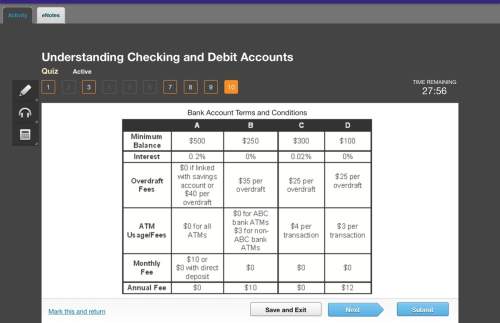
Business, 22.06.2021 21:40 nayelidlc2
why does levying unit tax lead to deadweight losses please use consumer surplus and producer surplus to explain

Answers: 1


Other questions on the subject: Business

Business, 22.06.2019 00:40, tenleywood
The silverside company is considering investing in two alternative projects: project 1 project 2 investment $500,000 $240,000 useful life (years) 8 7 estimated annual net cash inflows for useful life $120,000 $40,000 residual value $32,000 $10,000 depreciation method straightminusline straightminusline required rate of return 11% 8% what is the accounting rate of return for project 2? (round any intermediary calculations to the nearest dollar, and round your final answer to the nearest hundredth of a percent, x. xx%.)
Answers: 3

Business, 22.06.2019 03:30, skylar1315
Used cars usually have options: higher depreciation rate than new cars lower financing costs than new cars lower insurance premiums than new cars lower maintenance costs than new cars
Answers: 1

Business, 22.06.2019 04:00, brucewayne8499
Consider the market for gasoline. suppose that, in a competitive market without government regulations, the equilibrium price of gasoline is $3.00 per gallon, and employees at gas stations earn $17.50 per hour. complete the following table by indicating whether each of the statements is an example of a price ceiling or a price floor and whether it results in a shortage or a surplus or has no effect on the price and quantity that prevail in the market. statement price control effect the government has instituted a legal minimum price of $3.40 per gallon for gasoline. the government prohibits gas stations from selling gasoline for more than $3.40 per gallon. due to new regulations, gas stations that would like to pay better wages in order to hire more workers are prohibited from paying more than $14.50 per hour.
Answers: 2

Business, 22.06.2019 05:10, russboys3
The total value of your portfolio is $10,000: $3,000 of it is invested in stock a and the remainder invested in stock b. stock a has a beta of 0.8; stock b has a beta of 1.2. the risk premium on the market portfolio is 8%; the risk-free rate is 2%. additional information on stocks a and b is provided below. return in each state state probability of state stock a stock b excellent 15% 15% 5% normal 50% 9% 7% poor 35% -15% 10% what are each stock’s expected return and the standard deviation? what are the expected return and the standard deviation of your portfolio? what is the beta of your portfolio? using capm, what is the expected return on the portfolio? given your answer above, would you buy, sell, or hold the portfolio?
Answers: 1
You know the right answer?
why does levying unit tax lead to deadweight losses please use consumer surplus and producer surplus...
Questions in other subjects:



Mathematics, 18.02.2021 03:30

Mathematics, 18.02.2021 03:30

Mathematics, 18.02.2021 03:30

History, 18.02.2021 03:30


History, 18.02.2021 03:30

Mathematics, 18.02.2021 03:30

Mathematics, 18.02.2021 03:30




